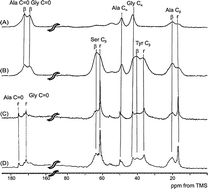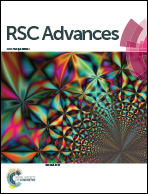Characterization of silk sponge in the wet state using 13C solid state NMR for development of a porous silk vascular graft with small diameter†
Abstract
The 13C solid state NMR spectra of the sponge prepared from Bombyx mori silk fibroin with different 13C labeling sites, [3-13C]Ser, [3-13C]Tyr and [3-13C]Ala were observed in dry and wet states. Here the silk fibroin sponge was prepared using poly(ethylene) glycol diglycidyl ether (PGDE) as porogen. Two broad peaks assigned to β-sheet and random coil were observed for each 13C-labeled site in the dry state. Moreover, in the wet state, one additional sharp peak assigned to random coil with high mobility due to the presence of water was observed. When the silk fibroin aqueous solution and PGDE was mixed in the sponge preparation process, the slow structural change from random coil to β-sheet structure occurs together with decrease in the motion of the silk fibroin backbone chain. The silk fibroin graft with small diameter was prepared with a knitted silk fiber tube coated with this silk fibroin sponge. The high porosity and suture retention strength which are comparable to an ePTFE vascular graft were attained. The excellent results, high patency and high tissue ingrowth, were obtained with the porous silk fibroin graft with small diameter by a rat abdominal aorta implantation experiment.


 Please wait while we load your content...
Please wait while we load your content...